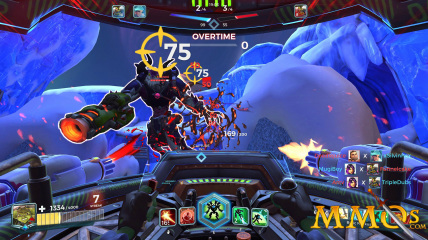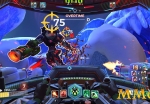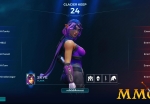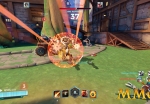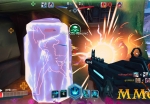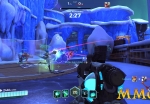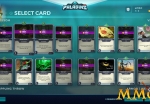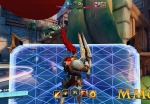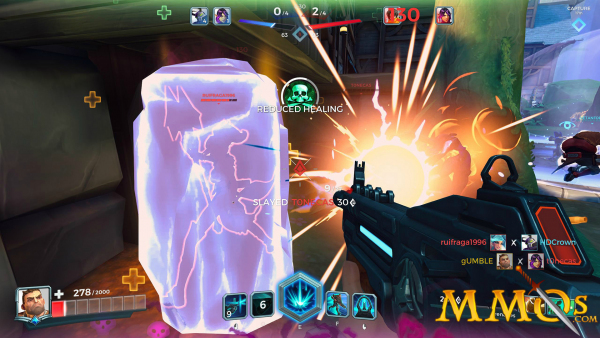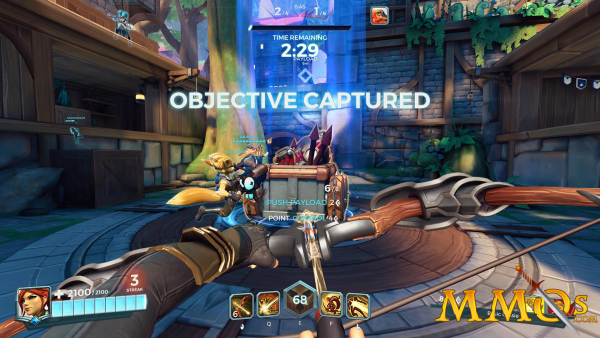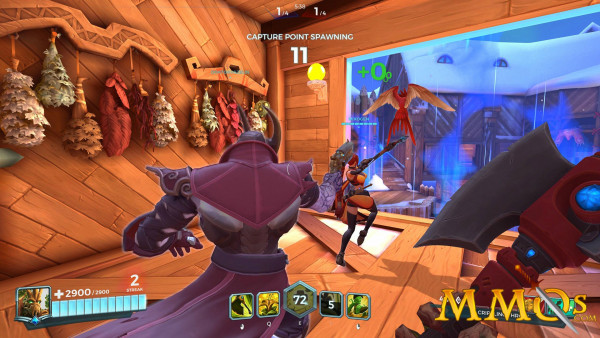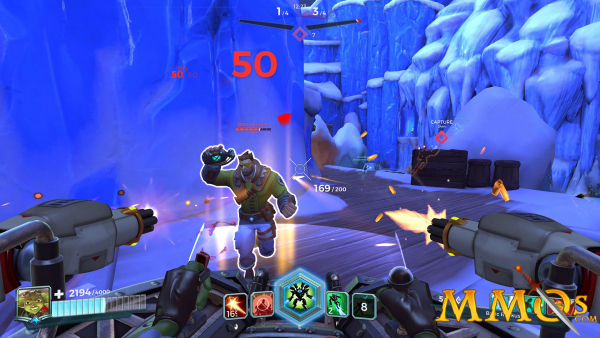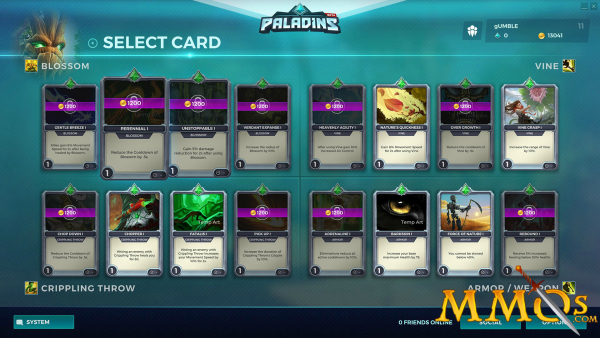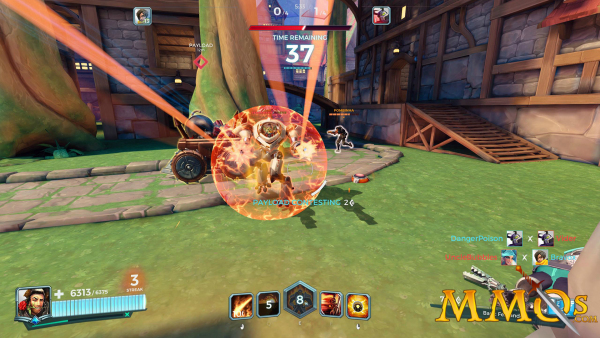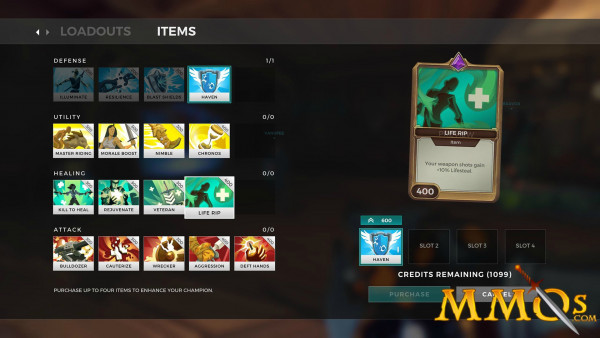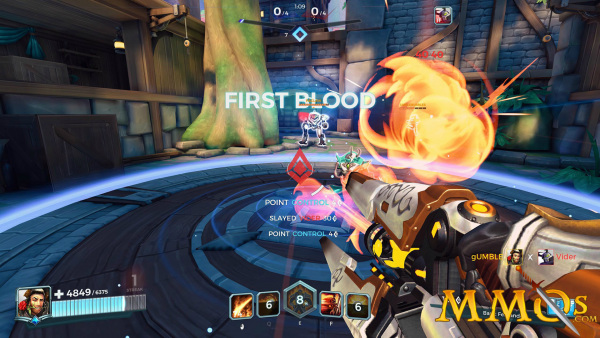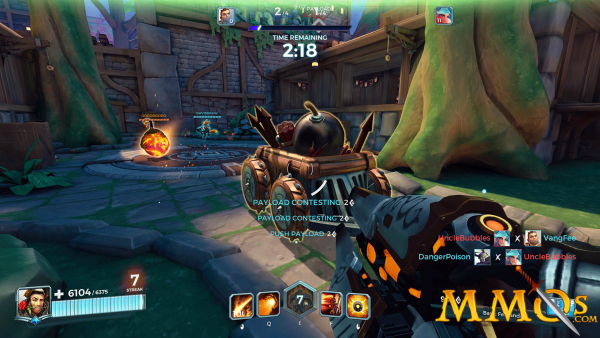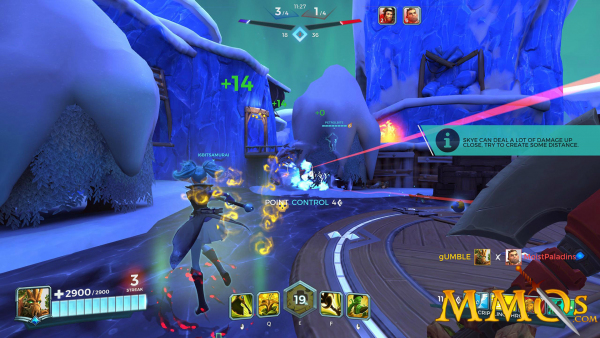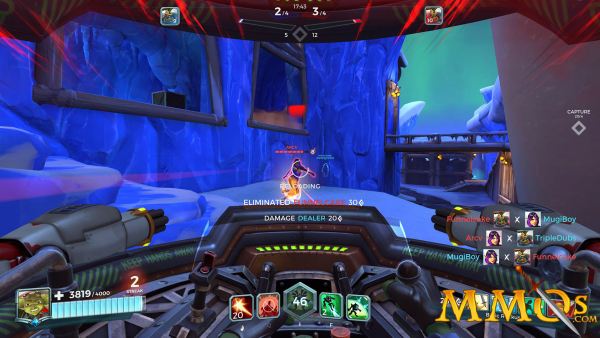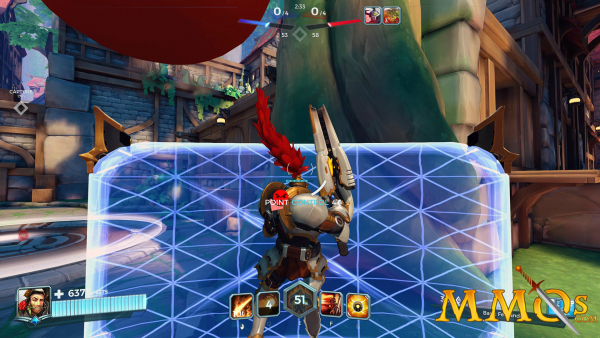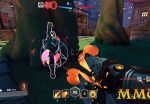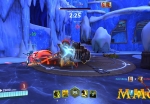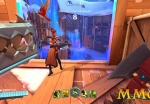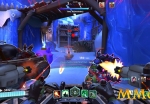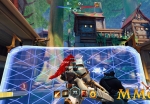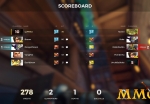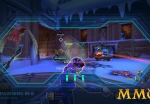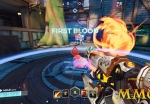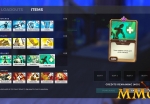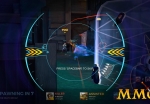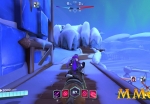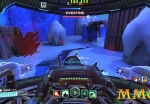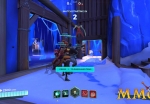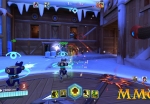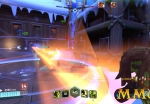Paladins
Paladins: Champions of the Realm is a hero-based cooperative shooter where teams brawl to capture and deliver objectives. Players select between a variety of champions, customizing their playstyle with cards and items.
| Publisher: Hi-Rez Studios Playerbase: High Type: F2P Team Shooter Release Date: September 15, 2016 Pros: +Wide variety of champions. +In depth ability customization system. +Crisp clean visuals. Cons: -High barrier to play ranked. -Sound effects feels a bit underwhelming. -Repetitive map design. -Matchmaking balance issues. |
Paladins: Champions of the Realm Overview
Paladins: Champions of the Realm is a team-based shooter where players select between a variety of heroes and fight to capture objectives. Brawl it out in 5v5 matches as one of a colorful cast of characters, each imbued with their own abilities. Players can further customize their characters by enhancing some abilities over others through an extensive card system. Work together to secure the objective and then escort a cart to the opposing team's base to win the round. The first team to secure 4 points wins the game. Further customize your hero by purchasing items with currency earned during a match. Rank up your heroes and enter competitive play to test your skills and ability to work with other players to make split decisions that will either win or lose you the game.
Paladins: Champions of the Realm Key Features
- Team Based Gameplay - Take part in 5v5 matches that require teamwork and the strategic use of each player's unique abilities and weapons.
- Stack the Deck - Earn cards which offer boosts to various stats, abilities, and weapons and further customize your hero's playstyle.
- Colorful Aesthetic - a cool, vivid aesthetic is both pleasing to the eye and should run on most modern computers.
- Items - earn currency by fighting enemies and capturing the objective to purchase items to further enhance your character.
- Close Quartered Maps - simple map design channels players to constantly engage in all-out brawls with one another.
Paladins Screenshots
Paladins Featured Video
Paladins Review
By, Sean Sullivan
Paladins is flexing its muscles as the latest big dog on Steam, with a steadily increasing player base each passing day since launch. Seems shouting the word “clone” is a call for more players to sign up. But the game isn’t popular for mimicking any other game. The hero-based cooperative brawler is easy to get into and difficult to master: a shining trait for any game that wants to reach a wide audience. And thanks to its card-based character customization Paladins has climbed the charts for good reasons.
A Regular Match
Gameplay is straightforward: two teams start at opposite ends of the map and have to secure an objective in the middle. Whoever fills in the capture ticker unlocks a cart—earning a point— which they then escort towards the enemy spawn (à la Team Fortress 2, Overwatch, Chivalry, etc.)—earning another point if they succeed. The first team to earn 4 points wins. So you play round after round until a team can finally boast victory.
Thanks to Paladins’ simple map design you’re constantly thrust into fierce brawls for control of the objective. Environments are small: a main hallway with various pathways on either side to promote flanking and sneaky long-range picks; always watch your sides, and swivel to check behind you. Because the name of the game is the objective. You need to work together to make sure your team is capturing the point, otherwise you lose.
Paladins is not a Team Deathmatch, no matter how many players try and play it like one. So that the worst thing you can do in a match is die.
Stay out of combat long enough and you’ll regenerate health, making every engagement a tactical choice. Do I fire on that Drogov at half health or hide behind this ice wall to heal up and increase my chances of survival? It’s curious split-second decision making that’s part of any game with rechargeable health. Sometimes you take the risk, sometimes you play conservatively—it all depends on your champion.
The Roster
Champions are broken into 4 categories: Front Line, Damage, Support, and Flank (I appreciate flank as it’s own category, telling you it’s the playstyle you ought to adopt). You need to mix and match. A well-balanced team, just like breakfast, needs a little bit of everything. If you’re a puggie superstar you might think it doesn’t matter but if you plan on playing seriously your team’s going to want at least a tank and healer, and a mish-mash of the rest.
Each hero has five abilities players juggle throughout a match. Better study up and know when to use them. Most heroes have a healthy mix: something to do damage with, an escape, a support effect, and their ultimate. By engaging in combat you’ll build up your ULT, and then—hopefully—unleash it at the right time.
I enjoyed the diversity of playstyles between heroes, enough to keep the game interesting if you rotate after each match. Barik is the master of turrets, placing them in optimal spots to dish out damage and distract enemy firepower. While Skye is an annoyingly sneaky assassin flanking opponents with an onslaught of pellets before disappearing into the shadows. And a champion's playstyle can be further customized but first you have to learn how to play them and use them against other heroes.
Some heroes take time to learn. Looking at Drogov I thought he could soak up damage based on his demonic size. But I quickly learned he was a squishy hit-and-run character, firing missiles from afar. Whereas Cassie is great for picking opponents hanging out on rooftops and knocking enemies off the the objective with an explosive shot. While her movement speed is slow a dodge rolls enables her to quickly duck behind cover before peeking out to fire off an arrow.
No Lore, No Big Deal
There’s no obvious lore for heroes—nothing to establish the realm’s conflict—so if you’re the type of person who needs narrative to feel immersed you might be disappointed. Not that I do. The character designs are vivid enough that heroes wear their personalities on their sleeves, and through voice acted one-liners. It’s a charming mix with a cool colored style that sets Paladin's heroes and it's worlds apart.
An Abacus Made Of Cards
Cards add an unexpected layer of complexity to Paladins. Each hero is equipped with 5 cards; you can choose to roll in matches with the game’s default—basic—deck or customize your own once you’ve earned some cards from Radiant Chests or by purchasing them with gold earned in-game by playing matches.
Cards are segmented between 4 playstyles according to which ability they fall under. You can mix and match between different playstyles, or choose to go all-in on one. “Do I want to rely on Cassie’s dodge roll to avoid damage and dish out quick shots? Or should I enhance Blast Shot, to sit back and knock enemies off the objective? Maybe I ought to find a balance between the two.”
By default each card is worth 1 point, and you need to fill up 12 points for a complete deck. So what do you do? You increase the level of some cards over others, increasing its point value, up to 4. The higher the level, the more powerful the boost. It’s Paladin's abacus, weighing the relative benefits of cards to decide which ones you want to emphasize.
I tried to do an all-out crippling throw spec for Grover to see how much of a difference speccing into one series of cards makes, and to find out if a balanced approach is necessary. The spec worked. I was clocking heads with my spinning axe left and right, even taking over the scoreboard as a support champion. Whether or not it would be long-term viable against a cooperative team is another question. But it’s fun to play around with boosting abilities, and creates replay value for individual champions.
Insider Trading
The best part of any game with hero customization is the community that forms to share playstyles. While the game is still in its early stages, players are posting their builds to discuss what works best, how to improve, and offer critiques, to figure out what’s optimal. And the best time to experience the community is when a game first releases, or right after a patch, before people proselytize godly setups that the entire community soon adopts before the meta is changed.
Although, what’s nice about Paladins is its apparent ability to spec into multiple viable builds. Play a Grover that focuses on dishing out damage, or concentrate on keeping your team healed. You can refine your spec as a support class: support from afar by throwing axes or active healing to stay on the point.
“I Would Like One Lifesteal Please”
At the start of every round you’re prompted to purchase an item with an allowance of 400 credits. Items aren’t really items, even though they’re designated as such; since they’re presented as cards “Buffs” might have been more appropriate. Items are broken into four categories: Defense, Utility, Healing, and Attack. Players can purchase one item from each category, given that they earn enough coinage during a game by making contact with enemy domes and working towards the objective.
It’s further customization, a way to bolster your stats to compensate your character. I might take Life Rip from the Healing tier: “your weapon shots gain +10% Lifesteal,” especially if I’m playing a hero like Viktor where I’m constantly firing bullets at an enemy. While a single-shot doesn’t do much damage, a constant barrage will help keep me alive.
Some items don’t seem as useful within the same tier, such as Master Riding which increases Mount Speed. I would rather improve my hero's movement speed or reduce the cooldown of my abilities, since mounts rarely play a role outside of moving from spawn to combat.
The Importance Of Gusto
Weapons lack gusto, there’s no weight behind their attacks. Androxu’s pistol shots feel like I’m shooting gumballs, not deadly bullets. And Ricardo’s flamethrower doesn’t do burn damage? Why not? Is everyone wearing fire retardant? I guess I get why. It would mean trading off his base damage for DOT burns, but it’s an odd fix: it diminishes any realism. But my overall point: weapons don’t feel like weapons. Instead, they’re toys on a make believe playset. And that’s sound issue. When I fire a missle let me feel the explosion; whereas arrows ought to zing as I shoot them.
Hit Boxes Need To Go On A Diet
Got some big ol’ hit boxes in Paladins. So long as you shoot within a sizable square around your opponent you’re going to do damage; you can shoot a good head width to the left or rights of a nose and still make contact. It’s as if every attack shoots out at an arc.
Wide hitboxes aren’t too much of a deal breaker because they seem to be ubiquitous across all champions. What it means is, lots of damage is getting slung around with few misses. And this isn’t exactly Counter-Strike: Global Offensive or any other tactical shooter; the game’s emphasis isn’t on pinpoint accuracy but abilities and team interdependence.
But the payload is a tank. When an enemy team is escorting the payload the cart deceives your shots. You think you can pop a head, but the cart hitbox extends too far beyond its model. Why not make the payload bigger so players can still hide behind it, but attackers know where to line up their sights?
“Haven’t I Seen This Map Before?”
Paladins’ maps are okay, but repetitive and stale. They lack charm, serving primarily to provide an even playing field between two teams: a symmetrical standard where you’ll find the same hallways around a central objective with cardboard cutouts to fire from cover across the maps.
Don’t get me wrong, the maps look good. They have a soft, visually pleasant aesthetic, but their design doesn’t elicit personality, serving to set up a place to do battle with enough routes on either side of a primary hallway to flank opponents and set up sneaky strats.
Versatility Is Key
My big issue with any character-based shooter is that players fall into the groove of one or two heroes and they never switch, not even if the team is lacking a tank or support class. One fix might be an alert at the start of a match that suggests what a team is lacking, e.g. “Take hero recommended” or “not enough Flank heroes.” Little messages like the aforementioned are akin to “please don’t litter.” They motivate behavior leading to a more well-rounded team.
Especially since Paladins has no obvious hero counters, one player can’t cancel out an opposing champion and fulfill their role by hampering a single opponent. You have to play into your team’s strengths and weaknesses to create the most balanced composition possible: a tank, a healer, a DPS, a annoying hit-and-run Skye. Be versatile, try other champions and take a risk by filling in the missing role your team needs.
Cash Shop
Paladins’ cash shop is innocuous. You buy crystals with cash, which can be exchanged for cosmetics: new skins to deck out your character and show your support for the game’s development. Crystals are also used to unlock Radiant Chests, featuring skins and cards. But cards can also be purchased with gold earned by playing matches, so no gameplay avenue is locked for freemium players. Although you will need a Founder’s Pack to ensure that you have access to all future champions.
Final Verdict - Good
Paladins is a solid hero-shooter with enough nuances to differentiate itself and warrant the widespread praise it's received from players. While it suffers in the map diversity department, a fair roster of heroes and a game design that emphasizes constant brawls makes it an attractive addition to any Steam library. And hero customization through cards and items means the same hero on both teams could be fulfilling entirely different roles. By the time it releases from Early Access I imagine Paladins will be great.
Paladins Videos
Paladins System Requirements
Minimum Requirements:
Operating System: Windows XP / Vista / 7 / 8
CPU: Intel Dual Core / AMD X2 5600+
Video Card: Nvidia GeForce 7600 GT / ATI Radeon 2600 XT
RAM: 2 GB
Hard Disk Space: 10 GB
Recommended Requirements:
Operating System: Windows XP / Vista / 7 / 8
CPU: Intel Core i5 / AMD FX Series
Video Card: Nvidia GeForce GTX 400 series
RAM: 4 GB
Hard Disk Space: 10 GB
Official system requirements have not yet been released for Paladins. The requirements above our based on our experience and will be updated when official numbers become available.
Paladins Music & Soundtrack
Coming soon...
Paladins Additional Information
Developer: Hi-Rez Studios
Other Platforms: PlayStation 4, Xbox Online (in development)
Game Engine: Proprietary game Engine
Open Beta Date: September 16, 2016
Steam Release Date: September 16, 2016 (Open BEta)
Release Date: September 16, 2016
Development History / Background:
Paladins: Champions of the Realm is Hi-Rez Studio's third first person shooter (FPS) title. The Alpharetta, Georgia based studio was one of the earliest American developers to embrace free to play. Their first game, Global Agenda was released in 2010 followed by Tribes: Ascend in 2011. Paladins entered Open Beta and was released on Steam as an Early Access title on September 16, 2016.
